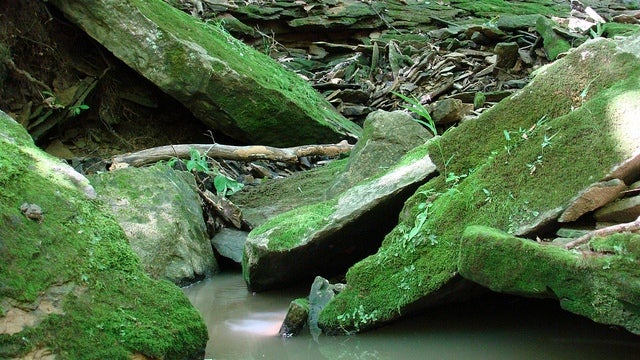 |
| Mosses and liverworts are amongst the earliest and most primitive land plants |
The animal transition from water to land is well documented, in particular the anatomical challenges faced by the early tetrapods. Yet plants colonised land long before animals.
They faced significant challenges: preventing cells from desiccation and creating a system to allow gas exchange. Land plants evolved from a group of green algae known as the charophytes. Charophytes are aquatic and precisely how they managed to make the move to a terrestrial environment is disputed.
They faced significant challenges: preventing cells from desiccation and creating a system to allow gas exchange. Land plants evolved from a group of green algae known as the charophytes. Charophytes are aquatic and precisely how they managed to make the move to a terrestrial environment is disputed.
One model involves the symbiotic relationship between an charophyte algal cell and a fungus known as arbuscular mycorrhizome. Such fungi still exist today and help plant roots obtain nutrients and water from soil. In exchange the fungi receive carbon-containing compounds such as sugars from the plant. Discoveries of 450 million year old fossilised spores similar to those of arbuscular mycorrhiza suggest that they would have been present in the environment encountered by the first land plants.
 |
| Closterium strigosum was one of the charophyte alga analysed in the study |
Yet the charophytes would have had to been land-bound to encounter such fungi, nor is it likely that they would have survived long enough to develop this complex symbiotic relationship.
What this implies is that this must have first evolved in water. To confirm this a team of researchers, led by Dr Pierre-Marc Delaux from the University of Wisconsin, Madison, analysed the DNA and RNA of groups of the most primitive living land plants, and charophytes.
What this implies is that this must have first evolved in water. To confirm this a team of researchers, led by Dr Pierre-Marc Delaux from the University of Wisconsin, Madison, analysed the DNA and RNA of groups of the most primitive living land plants, and charophytes.
They found that the crucial genes which underpinned the symbiotic relationship in plants were also present in certain charophyte algae.
'At some point 450 million years ago, alga from the earth's waters splashed up on to barren land,' said Dr Delaux. 'Somehow it survived and took root, a watershed moment that kick-started the evolution of life on earth. Our discovery shows for the first time that the alga already knew how to survive on land while it was still in the water. Without the development of this pre-adapted capability in alga, the earth would be a very different place today. This finding has filled a gap in our collective knowledge about the origins of life on earth.'
'At some point 450 million years ago, alga from the earth's waters splashed up on to barren land,' said Dr Delaux. 'Somehow it survived and took root, a watershed moment that kick-started the evolution of life on earth. Our discovery shows for the first time that the alga already knew how to survive on land while it was still in the water. Without the development of this pre-adapted capability in alga, the earth would be a very different place today. This finding has filled a gap in our collective knowledge about the origins of life on earth.'
Animals are clearly diverse in form and function. People might argue that plants are simple by comparison. Yet at the cellular level they are already more complex, possessing chloroplasts derived from endosymbiosis. In turn their ability to colonise the land has been helped by symbiotic relationships. Today even the tallest trees are built on these microscopic foundations.